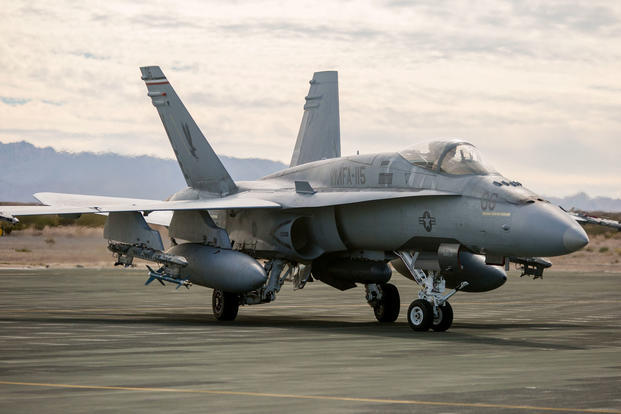Human error -- and miscommunication about runway lighting -- are to blame for a Marine Corps F/A-18C Hornet that skidded along a ditch and then burst into flames in an Oct. 26, 2016, mishap aboard Marine Corps Air Ground Combat Center 29 Palms, California, according to a command investigation.
The incident resulted in both the mishap pilot and the pilot leading the flight being assigned to field flight performance boards, and the mishap pilot ultimately being placed on conditional flight status, a spokesman for 2nd Marine Aircraft Wing, Capt. John Roberts, said in a statement.
The investigation, which was completed in February 2017, was released to Military.com on Tuesday through a Freedom of Information Act request.
The document reveals that the Marine Corps pilot, who safely ejected prior to the crash, had been inexperienced and "below average" in training progression on the aircraft.
No mechanical problems were identified on the aircraft, and no issues were discovered in the planning of the sunset training flight.
The pilot was part of the Beaufort, South Carolina-based Marine Fighter Attack Squadron 251, having recently joined the unit after completing replacement pilot training at Marine Fighter Attack Training Squadron 101, a Hornet fleet replacement squadron in Miramar, California. VMFA-251 was at 29 Palms at the time to complete an integrated training exercise.
The flight itself was unremarkable until around 6:15 p.m., when the mishap pilot prepared to land.
On final approach course, according to the investigation, the pilot leading the flight realized the runway lights were not on, and radioed the tower asking that they be turned on so he could see better. But as the mishap pilot approached the runway, the strip remained dark.
There was clear confusion as the pilot began a long final approach. He wasn't aware of a UH-1 Huey from a recent flight parked on a nearby taxiway, and overflew the aircraft's rotors by just 30-50 feet on descent. The aircraft then touched down briefly on a dirt track between another runway and a taxiway.
The Hornet's left landing gear tire landed in the middle of a drainage ditch, throwing the entire plane off-balance.
"The Mishap Pilot perceived everything to be normal up until the Mishap Aircraft touched down, then 'saw a rising shadow that looked like a dip then felt the jet hit the dirt, almost immediately the jet started to roll to the right' and began to violently come apart," the investigation reads.
About 450 feet on, the plane hit a culvert and burst into flames. Fortunately, the pilot had ejected when the Hornet's nose began to roll to the right and was safely away from the conflagration.
With the continued momentum from the landing, the burning aircraft continued to move along the dirt area by the drainage ditch before finally coming to a stop.
The investigation found the pilot's lack of situational awareness and overall confusion led to the crash.
"He mistook the dark stretch of the dirt area with the drainage ditch centered within in it and extending towards him and the flashing lights of the section of H-1 helicopters parked at the threshold for the unlit duty runway with the darkened runway centerline and no approach lights," the investigator wrote.
But it also found miscommunication about when to turn on the runway lights, and called the 29 Palms air traffic controller negligent for failing to put the lights on at sunset.
In his endorsement of the investigation, the commander of Marine Aircraft Group 31, Col. Robert Cooper, said the pilot lacked the tools he needed to address a "mitigatable" hazard, like a dark runway.
"I am confident that this mishap would not have occurred had FAA regulations been complied with," he wrote. "I'm also certain that the mishap would not have occurred if the pilot met the standard expectation of USMC aircrew levels of situational awareness."
-- Hope Hodge Seck can be reached at hope.seck@military.com. Follow her on Twitter at @HopeSeck.










